Divisibility: An Amusing Learning Guide for Grade 4
What is Divisibility?
Divisibility is a property of a number to be divided by another number without leaving a remainder. For example, if a number is divisible evenly-that is, without remainder-it is divisible by that number.
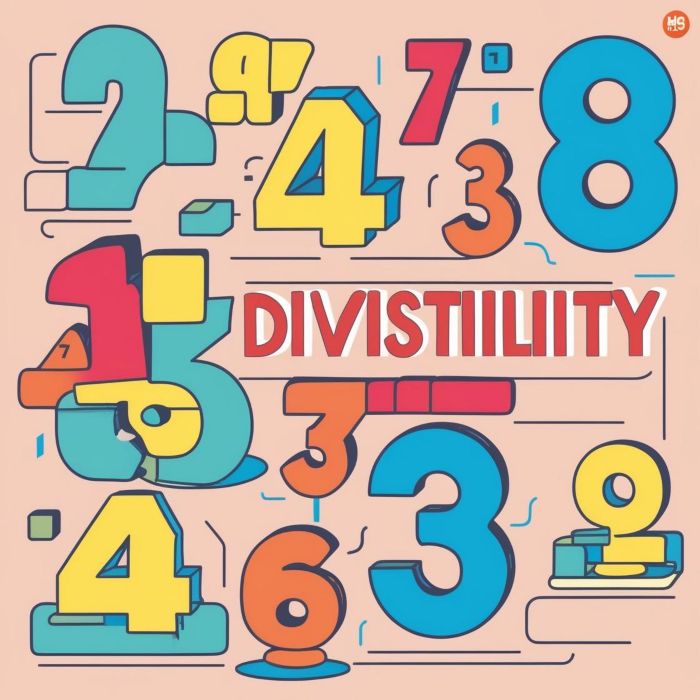
Divisibility rules are shortcuts that help you figure out very quickly whether one number can be divided by another number. Get into the rules for divisibility with common numbers!
Divisibility Rules for Common Numbers
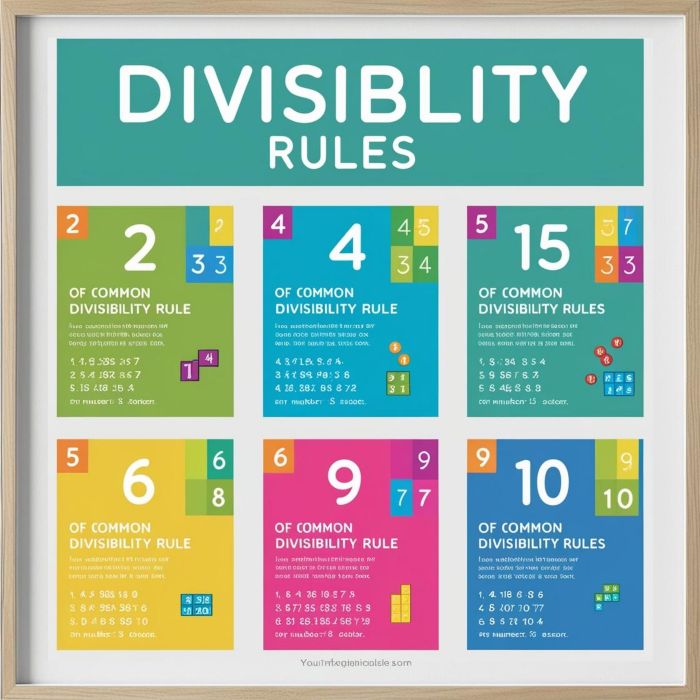
Divisibility by 2
A number is divisible by 2 if its last digit is 0, 2, 4, 6, or 8.
Example: Is 128 divisible by 2?
Yes! It ends in 8, so 128 is divisible by 2.
Divisibility by 3
A number is divisible by 3 if the sum of its digits is divisible by 3.
Example: Is 123 divisible by 3?
Add the digits: 1 + 2 + 3 = 6 (which is divisible by 3). Therefore, 123 is divisible by 3.
Divisibility by 4
A number is divisible by 4 if the number formed by the last two digits is divisible by 4.
Example:
Is 112 divisible by 4? The last two digits are 12, and 12 ÷ 4 = 3. Therefore, 112 is divisible by 4.
Divisibility by 5
A number is divisible by 5 if its last digit is 0 or 5.
Example:
Is 550 divisible by 5?
Yes! The last digit is 0, so 550 is divisible by 5.
Divisibility by 6
A number is divisible by 6 if it is divisible by both 2 and 3.
Example:
Is 36 divisible by 6?
36 ÷ 2 = 18 (divisible by 2)
Adding the digits: 3 + 6 = 9 (divisible by 3)
Since 36 is divisible by both 2 and 3, it is also divisible by 6.
Divisibility by 9
A number is divisible by 9 if the sum of its digits is divisible by 9.
Example:
Is 234 divisible by 9?
Add the digits: 2 + 3 + 4 = 9, which is divisible by 9.
Therefore, 234 is divisible by 9.
Divisibility by 10
A number is divisible by 10 if its last digit is 0.
Example:
Is 790 divisible by 10?
Oui! The last digit is 0, so 790 is divisible by 10.
Example: Is 2728 divisible by 11?
Strange places (1st and 3rd digits): 2 + 2 = 4 .
Even places (2nd and 4th digits): 7 + 8 = 15 .
Diff: 15 - 4 = 11 which is divisible by 11. .
Therefore, 2728 is divisible by 11.
Divisibility by 12
A number is divisible by 12 if it is divisible by both 3 and 4.
Example: Is 144 divisible by 12?
144 ÷ 3 = 48 (divisible by 3)
The last two digits are 44, and 44 ÷ 4 = 11 (divisible by 4).
Since 144 is divisible by both 3 and 4, it is also divisible by 12.
Fun Divisibility Examples
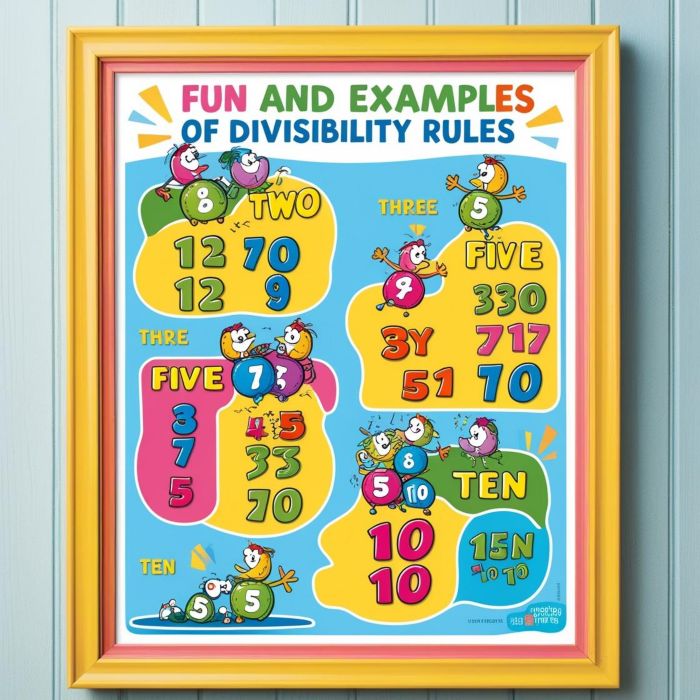
Here are a few more examples that use divisibility rules:
Divisibility by 2 Example: Is 784 divisible by 2?
Yes! The last digit is 4, which is even, so 784 is divisible by 2.
Divisibility by 3 Example: Is 99 divisible by 3?
Add the digits: 9 + 9 = 18 (which is divisible by 3). So, 99 is divisible by 3.
Divisibility by 4 Example: Is 320 divisible by 4?
The last two digits are 20, and 20÷4= 5.
So 320 is divisible by 4.
Divisibility by 5 Example: Is 1000 divisible by 5? Yes! The last digit is 0, so 1000 is divisible by 5.
Divisibility by 6 Example: Is 72 divisible by 6?
72 ÷ 2 = 36 (divisible by 2)
Add the digits: 7 + 2 = 9 (divisible by 3)
So, 72 is divisible by 6.
Quiz Time: Test Your Divisibility Skills!
1. Which number is divisible by both 2 and 3?
-
a) 15
-
b) 12
-
c) 7
-
d) 14
2. Is 156 divisible by 3?
-
a) Yes
-
b) No
3. Is 88 divisible by 4?
- a) Yes
- b) No
4. Which number is divisible by 5?
- a) 540 \
- b) 833 \
- c) 763 \
- d) 679 \
5. Is 120 divisible by 6?
-
a) Yes
-
b) No
Fun Facts:
Divisibility rules are shortcuts for faster math solving!
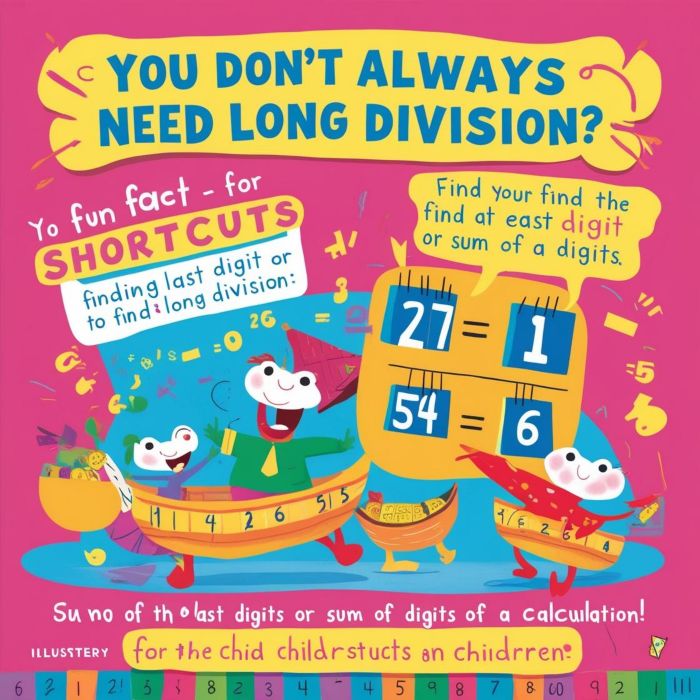
-
Do not do the long division every time you can solve the last digit or the sum of digits.
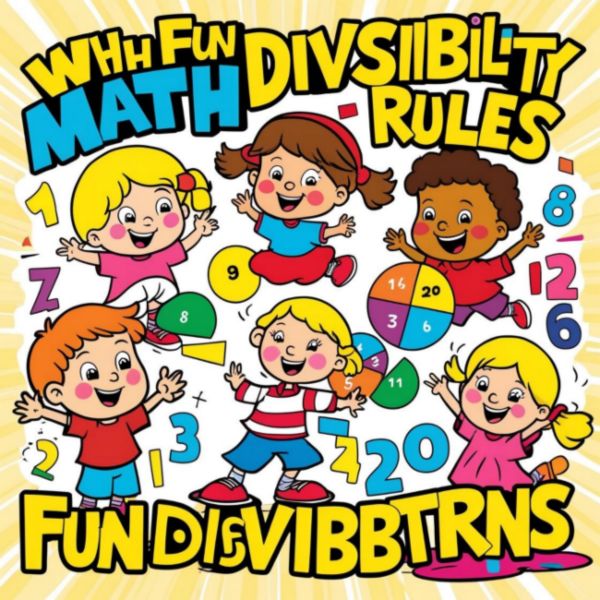
-
Recognizing divisibility patterns will help make the bigger calculations, such as the search for factors or simplification of fractions.
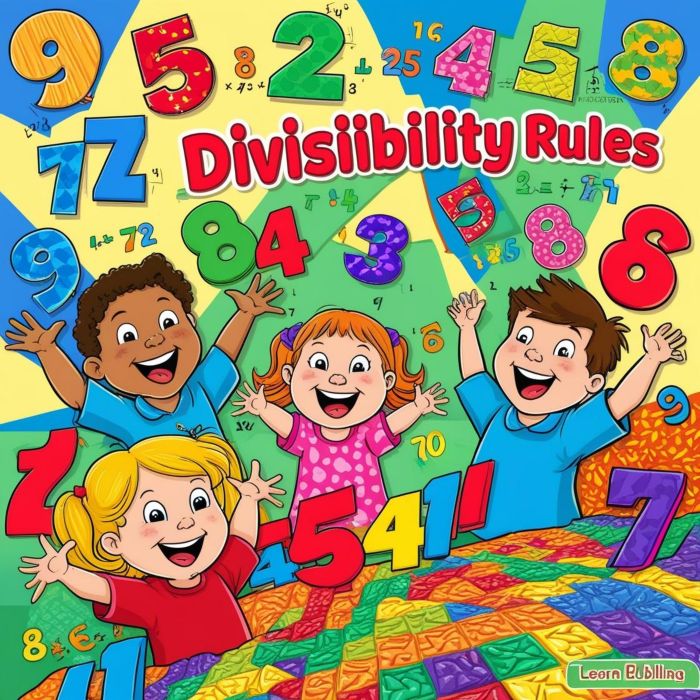
-
So now you learn the divisibility rules for such numbers and can immediately find out without long division whether the number is divisible by another number. The more you practice, the faster you perceive the patterns of division! Enjoy and do lots of exercises
FAQs
What are 4 divisibility rules?
The four basic divisibility rules are for 2, 3, 5, and 10. These rules help determine if a number can be divided evenly by these numbers without leaving a remainder.
What is the divisibility rule of 2, 3, 4, 5, 6, 7, 8, 9, 10?
-
2: Last digit is even (0, 2, 4, 6, 8).
-
3: Sum of digits is divisible by 3.
-
4: Last two digits form a number divisible by 4.
-
5: Last digit is 0 or 5.
-
6: Divisible by both 2 and 3.
-
7: No simple rule (divide and check).
-
8: Last three digits form a number divisible by 8.
-
9: Sum of digits is divisible by 9.
-
10: Last digit is 0.
How to write divisibility rules?
Divisibility rules are written as statements describing the condition (e.g., "A number is divisible by 2 if its last digit is even.").
What is the formula of divisibility?
There is no universal "formula" for divisibility, but each number has its own rule based on patterns in its digits.
Practice Worksheet
Easy Level Worksheets
Intermediate Level Worksheets
Advanced Level Worksheets
CBSE Schools In Popular Cities
- CBSE Schools in Bangalore
- CBSE Schools in Mumbai
- CBSE Schools in Pune
- CBSE Schools in Hyderabad
- CBSE Schools in Chennai
- CBSE Schools in Gurgaon
- CBSE Schools in Kolkata
- CBSE Schools in Indore
- CBSE Schools in Sonipat
- CBSE Schools in Delhi
- CBSE Schools in Rohtak
- CBSE Schools in Bhopal
- CBSE Schools in Aurangabad
- CBSE Schools in Jabalpur
- CBSE Schools in Jaipur
- CBSE Schools in Jodhpur
- CBSE Schools in Nagpur
- CBSE Schools in Ahmednagar
- CBSE School In Tumkur











